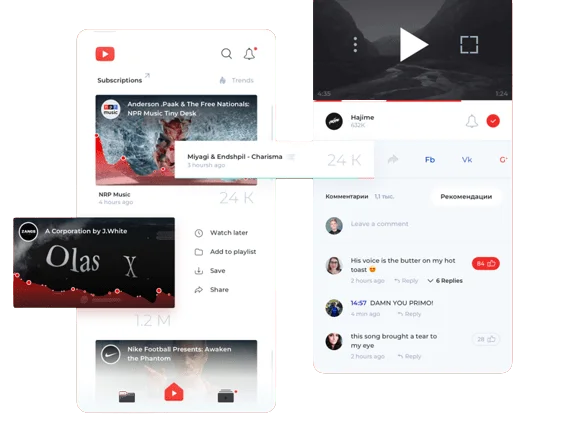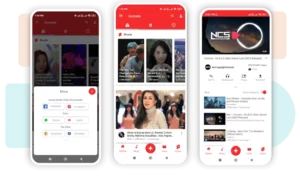Elite Video Sharing scripts to create your own video-sharing platform
What are Video Sharing Scripts and Platforms?
A video sharing script from Miracuves is a software application that allows users to upload, view, and share videos with included ad and bookmark features. It provides a venture for hosting and managing video script content, making it accessible to a wide audience. This type of platform can be used for various purposes, including entertainment, education, and marketing.
Using a video sharing platform offers several benefits. Our youtube clone allows users to express themselves creatively, share their experiences, connect with others through video content, and add videos to their personal bookmark list. From a business perspective, video sharing platforms can be used to promote products or services, engage with customers, and build brand awareness.
Video sharing platforms like Youtube work by providing users with tools to upload their videos, manage their content, interact with other users and bookmark their favorite videos. The video platform typically includes features such as video hosting, playback, commenting, sharing options, and ad placements to facilitate the seamless sharing and viewing of videos.
Introducing our Video Share Script – the ultimate tool for effortlessly sharing and streaming videos online. With user-friendly features and robust security, our script empowers you to create your own customized video-sharing platform. Share memories, engage audiences, and drive traffic like never before with our intuitive solution. Experience the future of online video sharing with ease and efficiency.

Key Features of the Best PHP Video Sharing Scripts
When looking on Miracuves for the best PHP video sharing script, there are certain features to consider. A robust video sharing script from Miracuves should offer features like a customizable video player, user-friendly interface, seamless video upload, and efficient admin panel for content management with SEO and advertisement features. These features ensure a smooth and engaging user’s experience.
The Video Share Script boasts an array of key features designed to enhance the user experience and streamline the video-sharing process:
- User-friendly Interface: A sleek and intuitive interface ensures effortless navigation for both creators and viewers, making it easy to upload, search for, and watch videos.
- Customizable Profiles: Users can personalize their profiles with profile pictures, bios, and customizable settings, creating a unique identity within the community.
- Seamless Video Upload: With support for various video formats and sizes, uploading videos is a breeze. Users can also add titles, descriptions, and tags to optimize their content for searchability.
- Social Sharing Integration: Integration with popular social media platforms enables users to easily share their favorite videos with friends and followers, expanding the reach of their content.
- Advanced Search Functionality: Robust search filters allow users to discover videos based on categories, tags, or keywords, ensuring they can find the content they’re interested in quickly and easily.
- Responsive Design: The script is optimized for mobile devices, ensuring a seamless viewing experience across smartphones, tablets, and desktops.
- Commenting and Interaction: Users can engage with content creators and fellow viewers through comments, likes, and shares, fostering a sense of community and collaboration.
- Monetization Options: Built-in monetization features such as advertising integration, subscription models, and pay-per-view options enable creators to monetize their content and generate revenue.
- Analytics and Reporting: Comprehensive analytics tools provide insights into video performance, audience demographics, and engagement metrics, empowering creators to make data-driven decisions to optimize their content strategy.
- Security and Moderation: Robust security measures, including user authentication, content moderation tools, and copyright protection mechanisms, ensure a safe and secure environment for all users.
Customizing a PHP video sharing script allows website owners to tailor the platform according to their specific needs, including option to insert ads. This includes incorporating branding elements, modifying the layout and design, adding custom functionalities like an advertisement module, subscriber benefits, and SEO capabilities to enhance the overall user experience on your full-fledged video streaming site.
Using a PHP script for video sharing provides several benefits, including flexibility, scalability, and a wide range of available plugins and extensions. Additionally, PHP based platforms like those found on Miracuves, are known for their robust security features, making it a reliable choice for creating a secure video sharing platform.
How to Create Your Own Video Sharing Platform?
Creating a full-fledged video sharing website involves several steps, including selecting a suitable video sharing script from Miracuves, setting up hosting, customizing the platform, enabling ad placements and ensuring a seamless user experience. Using a readymade video sharing script provides a convenient and efficient way to kick-start the development process.
Choosing the right video sharing script is crucial for the success of your online video sharing platform. A readymade video sharing script saves time and resources, allowing you to focus on other aspects of website development such as user engagement, content curation, and marketing strategies.
Hosting plays a critical role in the performance of your online video sharing platform. Choosing a reliable hosting provider and following best practices for website hosting is essential for ensuring smooth and uninterrupted access to the video content.
Monetization and User Experience in Video Sharing Platforms
Video sharing platforms offer various avenues for revenue generation, including advertising, subscription models, and premium content access. By implementing effective monetization strategies, website owners can generate revenue while providing valuable content to users.
Optimizing the venture for speed, usability, and interactivity is part of enhancing the user’s experience on video sharing websites. Providing seamless video playback, intuitive navigation, and interactive features such as ads contributes to a positive user experience, leading to increased engagement, subscriber retention and advertisement opportunities.
Robust video sharing solutions offer unparalleled features such as advanced analytics, content management tools, and social integration. These features empower owners of ventures to manage and grow their video script platform effectively, catering to the requirements of content creators and viewers alike.
Solution Demo -> Click Here

Mobile and Multi-functionality in best Video Sharing Script
Responsive design is crucial for SEO optimization of video sharing websites to ensure optimal viewing experience across various devices. Implementing a mobile-responsive design allows users to access and interact with video content seamlessly on smartphones, tablets, and other mobile devices.
Mobile app integration enhances the accessibility and user engagement of a video sharing platform. Developing server-based mobile apps for iOS and Android provides users with convenient access to upload videos, promoting user retention and expanding the venture’s reach.
Exploring additional functionality, such as advertisement and bookmarking features, through the admin panel of a video sharing script allows website owners to extend the platform’s capabilities. This includes features like content editing, user management, subscription modules, and integration with third-party services such as Vimeo and Dailymotion for importing unlimited videos.
Unlocking Potential: Exploring Versatile Video Sharing PHP Scripts for Your Online Streaming Platform
If you’re looking to create a versatile and scalable video sharing site, consider exploring video sharing PHP scripts available on platforms . These scripts, such as the Ultimate PHP Video CMS, offer comprehensive solutions for businesses and individuals who want to pave the way in the online video streaming platform market.
With features like SEO optimization, fully responsive designs, and fully secured infrastructure, these scripts are ready to use and integrate seamlessly with your business model.
Whether you’re an individual entrepreneur or a team of experts, these scripts provide regular updates and a team of experts to ensure your platform stays innovative and meets evolving business requirements. You can also bring in features such as membership plans, affiliate programs, and banner advertisements to monetize your venture effectively, while providing an engaging and comprehensive experience for the user.
By leveraging video sharing PHP scripts from platforms , you can quickly go live with a fully functional and scalable video sharing site. These scripts offer a full-fledged solution for uploading and streaming videos from sources like Dailymotion while incorporating keyword optimization and search engine compatibility to enhance visibility on search engines.
With a user-friendly interface and a versatile business model, these scripts cater to people who want to create their own streaming platform without the hassle of building the infrastructure from scratch. Whether you’re a budding entrepreneur or an established business looking to expand into the online streaming market, these scripts offer the flexibility and innovation needed to succeed in the digital age.
Introducing Miracuves’ revolutionary Video Share Script – the ultimate solution for seamless video sharing and streaming! Whether you’re a content creator, a business looking to engage customers, or an individual seeking to share memories, our script offers unparalleled functionality and ease of use.
With customizable features, intuitive interface, and robust security measures, Miracuves’ Video Share Script empowers you to create your own video-sharing platform tailored to your specific needs.
Experience the power of viral content sharing like never before. Our script allows users to upload, share, and interact with videos effortlessly, fostering community engagement and driving traffic to your platform.
With advanced analytics tools, you can track user engagement, monitor trends, and optimize your content strategy for maximum impact. Don’t miss out on the next big thing in video sharing – unlock the potential of Miracuves’ Video Share Script and take your online presence to new heights!

Frequently Asked Questions
What is a video sharing script?
A video sharing script is a software application or script that enables users to upload, share, view, and interact with videos online. It provides a full-fledged platform for users to create their own video-sharing websites or video streaming portals.
What features are commonly found in video sharing scripts?
Common features include user registration and profile management, video uploading and playback, commenting and liking videos, social sharing integration, search functionality, and monetization options such as advertising or subscription models.
Can I customize the appearance and functionality of a video sharing script?
Yes, many video sharing scripts offer customization options to tailor the platform to your specific needs. This may include customizing the design, layout, color scheme, and adding or removing features based on your requirements.
Is technical support available for video sharing scripts?
Many script providers on Miracuves offer technical support, documentation, and user forums where customers can seek assistance, troubleshoot server issues, and exchange ideas with other users. Some providers may also offer premium support options for additional assistance.
Is the Video Share Script customizable to fit my specific needs?
Absolutely! Our Video Share Script is highly customizable, allowing you to tailor the platform to your unique requirements. Whether you’re looking to integrate specific features, modify the user interface, or implement branding elements, our script can be adapted to match your vision.
How secure is the Video Share Script in terms of user data and content protection?
Security is our top priority. The Video Share Script comes with robust security measures to safeguard user data and protect uploaded content. We utilize encryption protocols, secure authentication methods, and regular security updates to ensure the highest level of protection against potential threats and unauthorized access.
Does the Video Share Script support monetization options for content creators?
Yes, our Video Share Script offers various monetization options for content creators to generate revenue from their videos. Whether it’s through advertising, subscription models, pay-per-view content, or merchandise sales, we provide flexible monetization strategies to help creators maximize their earnings and grow their audience.



























































